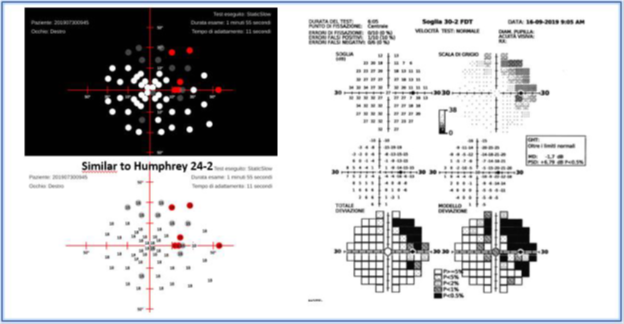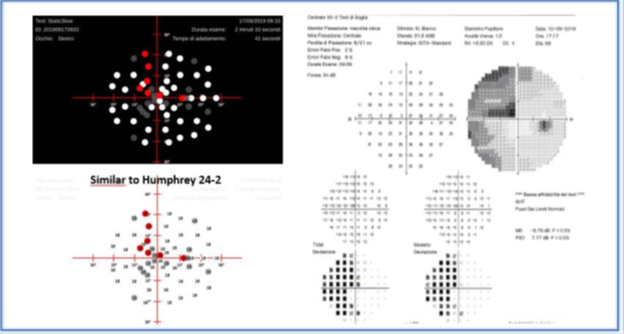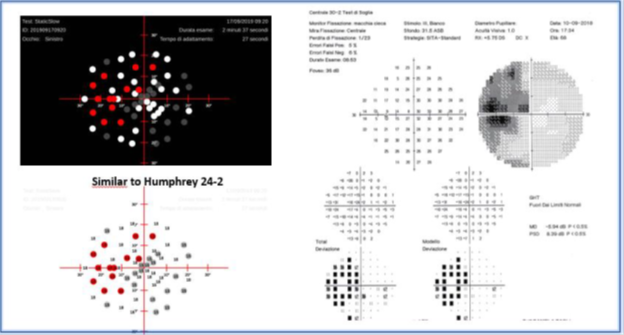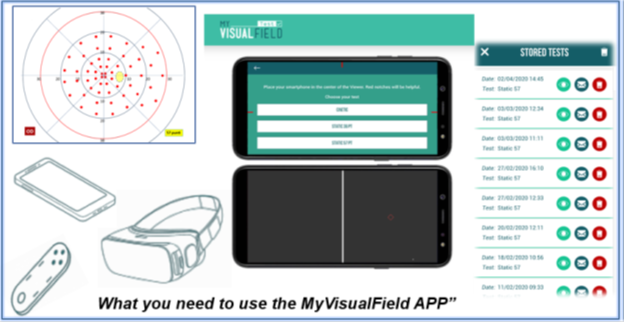MyVisualField©Static Test The Visual Field test Performed with a Smartphone and a Virtual Reality visor
Daniela Paoli1,2*, Luca Chittaro3, Paolo Brusini4, Lorenzo Michelin5,2
1Ophthalmologist, Former Head of Glaucoma Center, Monfalcone Hospital Gorizia, Italy
2National Glaucoma Patients Association (ANPIG), Italy
3Department of Mathematics and Computer Science at the University of Udine, Italy
4Ophthalmic Department Clinic in Udine, Italy
5Health Economics and Management, University of Bologna, Italy
*Corresponding Author: Daniela Paoli, MD, Ophthalmologist, Former Head of Glaucoma Center, Monfalcone Hospital Gorizia, Via Roma 39, 34074, Monfalcone, Italy, President of the National Glaucoma Patients Association (ANPIG)
Received: 19 January 2021; Accepted: 02 February 2021; Published: 08 February 2021
Article Information
Citation: Daniela Paoli, Luca Chittaro, Paolo Brusini, Lorenzo Michelin. MyVisualField© Static Test The Visual Field test Performed with a Smartphone and a Virtual Reality visor. Journal of Ophthalmology and Research 4 (2021): 96-100.
DOI: 10.26502/fjor.2644-00240028
View / Download Pdf Share at FacebookAbstract
laucoma is a progressive optic neuropathy characterized by loss of retinal ganglion cells (RGCs) and typical visual field defects. With more than 60 million people affected, it is nowadays considered a leading cause of irreversible blindness worldwide [1,2]. The goal of glaucoma management is to preserve the patient’s quality of life [3,4].
The rescheduling of work in hospital eye units during the COVID 19 pandemic has led to the prioritization of emergency operations and clinical work which cannot be postponed. This has consequently led to the cancellation or the postponement of a very high number of check-ups and tests which normally constitute follow-ups in cases of glaucoma and other chronic conditions. Online medicine and remote diagnostics have been under discussion for many years in view of the scarcity of specialist health workers available to perform check-ups and tests involving the use of medical equipment. The recent COVID 19 pandemic has underlined that today more than ever, online medicine is essential both for diagnostics and for follow-up.
Visual field examination is the standard for care in evaluating disease progression, and for clinicians it represents the driver for adjusting the management of the patient [5].
The MVF Static Test represents an evolutionary step forward from the previous MVF cinetic [6,7] and is a simple and inexpensive device for the detection of visual field defects for use by either patients themselves or by general practitioners.
Keywords
Visual Field; Smartphone; Virtual Reality; Glaucoma
Article Details
Objective
The aim of this study is to assess the possibility of using virtual reality to create a perimetric test which is usable by means of a mobile APP while retaining the essential elements of perimetry. Our aim was also to create an inexpensive test which is user-friendly for both patients and non-specialist healthcare staff for use either in the home or in general practice surgeries.
Methods
Under study were 65 volunteers between 23 and 88 years of age (130 eyes analyzed): 20 healthy patients with normal, standard visual fields, 5 patients with circulatory conditions and affected by hemianopia, and 40 glaucoma sufferers.
- Smartphone 5-inch touchscreen display (Android or iOS) with 1080x1920 pixel resolution.
- MVF (MyVisualField) static test APP installed on the smartphone.
- Bluetooth remote control equipped with a button compatible with Android and iOS smartphones.
- Zeiss VR ONE Plus virtual reality visor - Android and iOS smartphones equipped with 4.5–5.5-inch displays.
All of the participants underwent a visual field test with Sita 30-2 SITA Humphrey, 24-2 SITA Humphrey, or FDT Matrix programmes, before carrying out the tests with MyVisualField (MVF). At the conclusion of the test they were given a brief questionnaire.
Results
- The MyVisualField (MVF) test simulates a static perimetry test, using a fixed focal point and light targets of varying intensity.
- The luminosity problem with MVF is resolved, as with automated perimetry devices, by using a logarithmic scale. The production of the light stimuli is achieved through colour modulation by means of the RGB scale.
- Every test carried out with MyVisualField APP generates a graphic in real time on the mobile phone, which can be both exported and printed.
- Visual field tests carried out with MVF have an average duration (depending on the nature of the test) of around 1 to 2 minutes. Figures (1, 2, 3, 4).
Conclusions
MVF requires virtually no instrument or patient set-up and no use of trial lenses. Any staff member or any patient can operate MVF with very little training. Screening tests are performed in less than one or two minutes, set-up time is minimal, test times are short and results are easy to understand. The easily transportable MVF fits neatly into the pre-test area.
For patients with defects, the test was shown to be a useful counterpart to traditional methods. Many of the difficulties reported by the patients were associated with the sensitivity of the remote control. Notwithstanding the limits imposed by the system not having been certified for clinical use, the set objectives - which were to use virtual reality to carry out a test which provides a graphic readout of sensitivity and the difference between diseased and normal – were achieved.
By managing glaucoma and effectively delaying disease progression, we should expect to significantly reduce the economic burden of this disease.
References
- Cedrone C, Mancino R, Cerulli A, et al. Epidemiology of primary glaucoma: prevalence, incidence, and blinding effects. Progress in Brain Research 173 (2008): 3-14.
- Quigley HA. Number of people with glaucoma worldwide. British Journal of Ophthalmology 80 (1996): 389-393.
- European Glaucoma Society Terminology and Guidelines for Glaucoma, 4th Edition.
- Coleman AL. Glaucoma?. Lancet 35 (1999): 1803-1810.
- Gricar JA, Wilson PR, Cave DG. Glaucoma. Manag Care Interface 11 (1998): 42-44.
- Paoli D, Basso P, Chittaro L, et al. Visual field test based on Virtual Reality: design and implementation of the APP MyVisualField©(MVF) for Smartphones. 13°EGS Congress Florence. 19-22 May 2018 Poster 3.003
- Paoli D, Brusini P, Chittaro L. The examination of the visual field in virtual reality with your smartphone. Italian Perimetric Society Sipe16°Napoli, 11 Oct. 2019.






 Impact Factor: * 1.2
Impact Factor: * 1.2 Acceptance Rate: 79.45%
Acceptance Rate: 79.45%  Time to first decision: 10.4 days
Time to first decision: 10.4 days  Time from article received to acceptance: 2-3 weeks
Time from article received to acceptance: 2-3 weeks 
